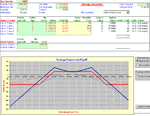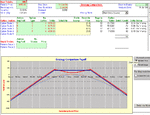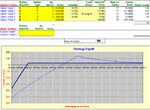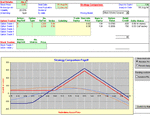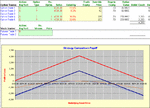You are using an out of date browser. It may not display this or other websites correctly.
You should upgrade or use an alternative browser.
You should upgrade or use an alternative browser.
Hi Keith - Iron Condors are just one of the tools I use to trade FTSE 100 options.
For the benefit of those who wonder what we're talking about, an iron condor is a short call, with a long call at a higher strike price to hedge losses in the event that the index rises substantially, plus a short put with a long put lower down to protect against unlimited losses in the event that the index collapses. The position profits provided that the price stays between the two short strikes. e.g short 1 x 4575 call, long 1 x 4675 call, short 1 x 4375 put, long 1 x 4275 put. The position provides maximum profit with expiry between 4375 and 4575.
For the benefit of those who wonder what we're talking about, an iron condor is a short call, with a long call at a higher strike price to hedge losses in the event that the index rises substantially, plus a short put with a long put lower down to protect against unlimited losses in the event that the index collapses. The position profits provided that the price stays between the two short strikes. e.g short 1 x 4575 call, long 1 x 4675 call, short 1 x 4375 put, long 1 x 4275 put. The position provides maximum profit with expiry between 4375 and 4575.
Hi Roger (M),
Thank you for your response. I have recently been introduced to what is obviously a variation of the Iron Condor.
The is consists of
Selling 4 Calls & Buying 1 Call at a lower Strike Price.
Buying 1 Put at an even lower Strike Price and Selling 4 Puts at yet an even lower Strike Price.
The long options are an "insurance" should the market become close to or go out side the boundaries of the Short options.
The object of the exercise is to allow the options to expire worthless.
Would you, or any of the board subscribers have any thoughts on this strategy when applies to FTSE 100 options?
Regards,
Keith.
Thank you for your response. I have recently been introduced to what is obviously a variation of the Iron Condor.
The is consists of
Selling 4 Calls & Buying 1 Call at a lower Strike Price.
Buying 1 Put at an even lower Strike Price and Selling 4 Puts at yet an even lower Strike Price.
The long options are an "insurance" should the market become close to or go out side the boundaries of the Short options.
The object of the exercise is to allow the options to expire worthless.
Would you, or any of the board subscribers have any thoughts on this strategy when applies to FTSE 100 options?
Regards,
Keith.
Keith - I'm not sure how you can compare an iron condor to the strategy you describe.
With an iron condor you are long and short equal numbers of contracts for both calls and puts. So, in the event of the market putting in a big move in either direction beyond the strike prices of your short options, the maximum loss to which you are exposed is limited to the difference between the strikes of the longs and shorts, less the net premiums taken in.
With the strategy you describe, you are long 1 x call and short 4 x calls, and long 1 x put and short 4 x puts. Therefore you are net short 3 calls and 3 puts, which means that you are open to ever increasing losses in the event of a big move outside the short strikes. In this respect, your position is a variation of a short strangle, or alternatively a 1 x 4 ratio call spread and a 1 x 4 ratio put spread, written back to back.
I've compared these positions in the pay-off diagrams shown below. The first diagram superimposes your position (blue) with a conventional iron condor (red). In the event that price moves towards the strike prices of the short positions, your position will show more profit. But in the event that prices move to more extreme positions in either direction, the losses just keep getting larger with your position, whereas they are limited with the traditional iron condor.
In the second pay-off diagram, if we compare your 1 x 4 position (red) with a conventional strangle (blue), with each position being net short 3 contracts, then your position shows slightly more profit near the strikes of the shorts, but less profit if expiry takes place in the middle of the range. Both positions show that unlimited losses can accrue in the event of a big move.
I tend to be allergic to holding large naked put positions for any length of time, so nearly always try to protect them with long puts further down. I am less worried about naked calls as there is little likelihood of the FTSE spiking 500 points higher at the open, whereas there are many reasons why a market can spike 500 points down.
Of course, I don't have the rationale behind the position you have described, and there may be times when it would be beneficial and show a better P/L profile. Perhaps you could let us know more?
With an iron condor you are long and short equal numbers of contracts for both calls and puts. So, in the event of the market putting in a big move in either direction beyond the strike prices of your short options, the maximum loss to which you are exposed is limited to the difference between the strikes of the longs and shorts, less the net premiums taken in.
With the strategy you describe, you are long 1 x call and short 4 x calls, and long 1 x put and short 4 x puts. Therefore you are net short 3 calls and 3 puts, which means that you are open to ever increasing losses in the event of a big move outside the short strikes. In this respect, your position is a variation of a short strangle, or alternatively a 1 x 4 ratio call spread and a 1 x 4 ratio put spread, written back to back.
I've compared these positions in the pay-off diagrams shown below. The first diagram superimposes your position (blue) with a conventional iron condor (red). In the event that price moves towards the strike prices of the short positions, your position will show more profit. But in the event that prices move to more extreme positions in either direction, the losses just keep getting larger with your position, whereas they are limited with the traditional iron condor.
In the second pay-off diagram, if we compare your 1 x 4 position (red) with a conventional strangle (blue), with each position being net short 3 contracts, then your position shows slightly more profit near the strikes of the shorts, but less profit if expiry takes place in the middle of the range. Both positions show that unlimited losses can accrue in the event of a big move.
I tend to be allergic to holding large naked put positions for any length of time, so nearly always try to protect them with long puts further down. I am less worried about naked calls as there is little likelihood of the FTSE spiking 500 points higher at the open, whereas there are many reasons why a market can spike 500 points down.
Of course, I don't have the rationale behind the position you have described, and there may be times when it would be beneficial and show a better P/L profile. Perhaps you could let us know more?
Attachments
Dear RogerM
Thanks for giving details about iron condor. Is it possible to give some hypothetical figures on premiums received/paid for call/put? Is it a net credit transaction?
Have you tried this strategy in DIA and QQQ or any other US index options?
Thanks for your input
Thanks for giving details about iron condor. Is it possible to give some hypothetical figures on premiums received/paid for call/put? Is it a net credit transaction?
Have you tried this strategy in DIA and QQQ or any other US index options?
Thanks for your input
Thank you
Thank you, Roger. I will contact you in due course when I have studied the charts some more..
I appreciate your assistance.
Regards,
Keith
Thank you, Roger. I will contact you in due course when I have studied the charts some more..
I appreciate your assistance.
Regards,
Keith
RogerM said:Keith - I'm not sure how you can compare an iron condor to the strategy you describe.
With an iron condor you are long and short equal numbers of contracts for both calls and puts. So, in the event of the market putting in a big move in either direction beyond the strike prices of your short options, the maximum loss to which you are exposed is limited to the difference between the strikes of the longs and shorts, less the net premiums taken in.
With the strategy you describe, you are long 1 x call and short 4 x calls, and long 1 x put and short 4 x puts. Therefore you are net short 3 calls and 3 puts, which means that you are open to ever increasing losses in the event of a big move outside the short strikes. In this respect, your position is a variation of a short strangle, or alternatively a 1 x 4 ratio call spread and a 1 x 4 ratio put spread, written back to back.
I've compared these positions in the pay-off diagrams shown below. The first diagram superimposes your position (blue) with a conventional iron condor (red). In the event that price moves towards the strike prices of the short positions, your position will show more profit. But in the event that prices move to more extreme positions in either direction, the losses just keep getting larger with your position, whereas they are limited with the traditional iron condor.
In the second pay-off diagram, if we compare your 1 x 4 position (red) with a conventional strangle (blue), with each position being net short 3 contracts, then your position shows slightly more profit near the strikes of the shorts, but less profit if expiry takes place in the middle of the range. Both positions show that unlimited losses can accrue in the event of a big move.
I tend to be allergic to holding large naked put positions for any length of time, so nearly always try to protect them with long puts further down. I am less worried about naked calls as there is little likelihood of the FTSE spiking 500 points higher at the open, whereas there are many reasons why a market can spike 500 points down.
Of course, I don't have the rationale behind the position you have described, and there may be times when it would be beneficial and show a better P/L profile. Perhaps you could let us know more?
osho67 said:Thanks for giving details about iron condor. Is it possible to give some hypothetical figures on premiums received/paid for call/put? Is it a net credit transaction?
Have you tried this strategy in DIA and QQQ or any other US index options?
Osho67 - An iron condor is always put on for a credit. In the example shown, which was just picked from prices at the time of my posting to demonstrate a point, calls and puts are sold for 24.5 and 20.5 respectively, giving a credit of 45, and calls and puts are bought for 7.5 and 13.5 respectively, at a total cost of 21, so there is a net credit of 45 - 21 = 24 per strategy at £10 per point per strategy. So a 10 lot would raise premium of £2400.
In practice you can do better by legging in to the position. For instance, you could put on a short strangle, and then when price moves in a given direction you can buy some cheap protection at the other end. Or alternatively, if you think there might be a short term rally within the trading range around which you are placing your iron condor, you could sell a put backspread, and then when you judge that the rally is complete, you could sell a call backspread, both for a credit. Then so long as the trading range you have identified holds, you expect both backspreads to expire worthless so that you get to keep the premiums taken on both.
I do these mainly on the FTSE, but have tried small trades on the QQQ's, but they seem not to work as well (for me, anyway) as the FTSE.
Thanks Roger for your reply. May i ask something if you dont mind. What about the commission charges?I have an account with Options direct and they charge £22.50 for each leg. Not only that selling put or call can only be done via telephone and not online. If you are using IB , what are the charges for all four legs. If one does just one or two contracts to start with, commission can eat away lots of profit. Your reply much appreciated. How much margin will be required for one iron condor contract. Thanks.
It might be a good idea if you can write and explain one strategy every week -each having its own thread and we can build up a good reference manual on t2w.
Thanks for your time?
It might be a good idea if you can write and explain one strategy every week -each having its own thread and we can build up a good reference manual on t2w.
Thanks for your time?
£22.50 per leg!!! And that's with human intervention. In addition to IB look at OptionsXpress who chare $15 per 10 contract and it can be done online. Think or swim (www.thinkorswim.com) is also good.
Glenn
Experienced member
- Messages
- 1,040
- Likes
- 118
Fwiw - I use IB TWS for options trading. You cannot enter a multi-legged position as one order to LIFFE You have transmit one leg at a time. Not much good for spreads etc imho. e.g. If you are setting limits on the legs you may only get filled on one.
You can create and send multi-legged options orders for ISE traded instruments. The mechanics are all there in TWS to do it very nicely. Shame it doesn't work for LIFFE.
IB don't accept telephone order to open positions, only to close them.
I'm waiting to hear from IB when such trades will be able (if ever) to be done on LIFFE via TWS.
Otherwise I'll be considering other brokers.
Glenn
You can create and send multi-legged options orders for ISE traded instruments. The mechanics are all there in TWS to do it very nicely. Shame it doesn't work for LIFFE.
IB don't accept telephone order to open positions, only to close them.
I'm waiting to hear from IB when such trades will be able (if ever) to be done on LIFFE via TWS.
Otherwise I'll be considering other brokers.
Glenn
guys - the question of commissions is always a difficult one. I still use ODL because they look after me well, and were very helpful when I needed some hand-holding in the early days. £22.50 a side is expensive if you are only doing 1 contract, but if you are doing a 10 lot, it is less so. Then add in that when placing a strategy they invariably get me better that the basic prices shown on screen. For instance, I did a 10 lot strangle recently for which I gave a limit of 31 based on individual prices, and they got me 34. That's a 10% improvement, and on 10 lots represented £300, so a £45 fee was not so very terrible. For deals placed online the flat rate is £15, which covers multiple contracts.
osho67 - not sure I can commit to a strategy per week, but we can always add to the library, and building up a number of separate threads for different strategies is a good one.
osho67 - not sure I can commit to a strategy per week, but we can always add to the library, and building up a number of separate threads for different strategies is a good one.
Thanks Roger
Yes a agree one a week is not right but you can start a thread for some popular strategy and let interested members post their comments and ideas. Sure we donot want just textbook approach, bur feedback and explanations fro members is more useful.
Comment on margin requirements with odl when you have some time. Thanks
Yes a agree one a week is not right but you can start a thread for some popular strategy and let interested members post their comments and ideas. Sure we donot want just textbook approach, bur feedback and explanations fro members is more useful.
Comment on margin requirements with odl when you have some time. Thanks
The problem of how to make money by selling FTSE100 index options, and how important it is to understand the effect of IV, is all summarised in the pay-off diagram below. The Blue profile is the 4725 February 2005 straddle priced yesterday at a total of 167 with 70 days to expiry. The Red profile is an ATM straddle based on the prices for the Feb 2003 straddle with 70 days to expiry, which could have been sold for 409. The spread between the breakeven points for the Feb 2003 position was 818 points, whereas now for Feb 2005 it is just 334 points.
Attachments
Last edited:
Airthrey Capital
Well-known member
- Messages
- 370
- Likes
- 18
Roger.....
Are you using Hoadley?
Are you using Hoadley?
Airthrey Capital
Well-known member
- Messages
- 370
- Likes
- 18
I downloaded the Hoadley option strategy this morning.
It is very useful, but having problems changing some of the parameters on the spreadsheet.
For example, when trying to change the Risk Free Interest Rate, I am asked for a password....which I don't have.
It is very useful, but having problems changing some of the parameters on the spreadsheet.
For example, when trying to change the Risk Free Interest Rate, I am asked for a password....which I don't have.
Similar threads
- Replies
- 1
- Views
- 3K
- Replies
- 1
- Views
- 5K
- Replies
- 1
- Views
- 2K

